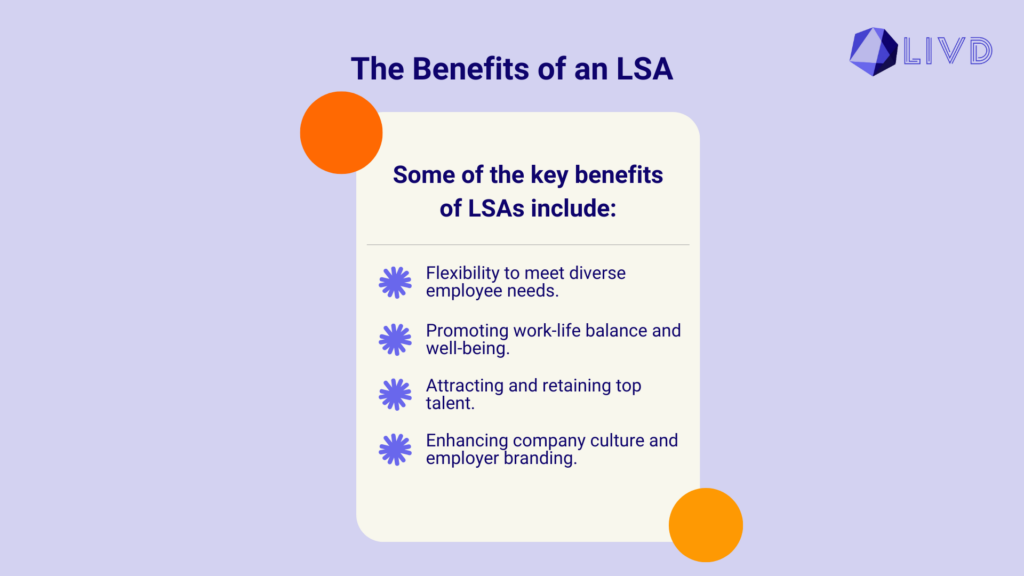The world of employee benefits is evolving — fast. Today’s workforce expects more than a paycheck and standard health coverage. They want flexibility, personalization, and support for the lifestyles they lead beyond the office.
That’s why Lifestyle Spending Accounts (LSAs) are gaining momentum among forward-thinking HR leaders. LSAs empower employees to choose the benefits that matter most to them — from fitness and wellness to family care, learning, and travel.
In this guide, we’ll break down what LSAs are, how they work, and why they’re becoming a must-have in every HR leader’s total rewards strategy.
What is a Lifestyle Spending Account (LSA)?
A Lifestyle Spending Account (LSA) is an employer-funded benefit that gives employees the freedom to use allocated dollars on lifestyle and wellness expenses of their choice.
According to SHRM, LSAs are “employer-sponsored accounts that enable employers to offer reimbursements to employees for merchandise and activities that promote physical, financial and emotional well-being. The accounts aren’t tax-advantaged, and they do not have the rules and restrictions typically associated with other traditional benefits accounts, like health savings accounts and flexible spending accounts.”
Unlike traditional benefits or tax-advantaged accounts (like HSAs or FSAs), LSAs are flexible and inclusive. They let employees decide what wellness and lifestyle mean to them — whether that’s:
- A gym or yoga membership
- A mental health app subscription
- Continuing education or coaching
- Family care or childcare
- Pet wellness or home office upgrades
In short, LSAs give employees the autonomy to use their benefits in ways that truly improve their quality of life.
The Rise of Lifestyle Benefits
The shift toward lifestyle benefits reflects a broader change in workforce expectations. Employees today want benefits that fit their lives — not the other way around.
With a workforce spanning multiple generations and life stages, the “one-size-fits-all” benefits model is becoming obsolete. LSAs meet employees where they are, offering a personalized approach that supports well-being, engagement, and inclusion.
For HR leaders, that means moving beyond standardized packages and embracing flexibility as a strategic advantage.
How LSAs Work — And Why They’re So Effective
Implementing an LSA is simple and scalable. Here’s how it works:
- Employer Funding – HR teams set a budget and allocate a specific dollar amount (or credits) to each employee’s LSA.
- Employee Choice – Employees spend those funds on approved categories defined by the employer — from fitness to family care to learning.
- Reimbursement or Direct Spend – Depending on your platform, employees can either request reimbursements or spend directly with pre-approved vendors.
- Flexibility Over Time – LSAs can be updated or restructured as employee needs evolve, keeping your benefits program fresh and relevant.
This structure makes LSAs both easy to administer and highly effective at improving satisfaction, retention, and employer branding.
The Benefits of a Lifestyle Spending Account
LSAs offer a host of benefits for both employers and employees.
For employers, LSAs can be a powerful tool for attracting and retaining top talent. They demonstrate an understanding of the diverse needs of the workforce and a commitment to supporting employees’ well-being.
For employees, LSAs provide the flexibility to choose benefits that truly matter to them. This can lead to increased satisfaction, engagement, and loyalty.
LSAs can have a positive impact on the overall company culture. They promote a sense of autonomy and trust, fostering a more engaged and satisfied workforce.
Some of the key benefits of LSAs include:
- Flexibility to meet diverse employee needs
- Promotion of work-life balance and well-being
- Attraction and retention of top talent
- Enhancement of company culture and employer branding

Flexibility to Meet Diverse Employee Needs
One of the main advantages of LSAs is their flexibility.
Unlike traditional benefits packages, which often come with rigid categories and limitations, LSAs allow employees to choose how they spend their benefits dollars.
This means that each employee can tailor their benefits to their unique needs and lifestyle.
Whether it’s a gym membership, a coding course, or childcare services, LSAs give employees the freedom to choose what matters most to them.
Promoting Work-Life Balance and Well-being
LSAs also play a crucial role in promoting work-life balance and overall well-being.
By covering a wide range of lifestyle-related expenses, they support employees in maintaining a healthy balance between their work and personal lives.
This can lead to improved mental and physical health, reduced stress, and increased productivity.
In essence, LSAs contribute to creating a healthier, happier, and more balanced workforce.
Attracting and Retaining Top Talent
In today’s competitive job market, offering a compelling benefits package is key to attracting and retaining top talent.
LSAs can give companies a competitive edge. They show prospective employees that the company values their individual needs and well-being.
By enhancing employee satisfaction and loyalty, LSAs can help reduce turnover and the associated costs.
In short, LSAs can be a strategic investment in the company’s most important asset: its people.
Implementing LSAs Through LIVD
LIVD makes it simple for organizations to launch, manage, and scale Lifestyle Spending Accounts. Our all-in-one lifestyle benefits platform helps HR teams modernize their total rewards strategy — without the administrative hassle.
Here’s how LIVD helps you bring LSAs to life:
- Easy setup and management: Configure, allocate, and track benefits all in one place.
- Seamless employee experience: Employees access a curated marketplace of lifestyle benefits across wellness, food, travel, and more.
- Flexible monthly credits: Allocate lifestyle credits that employees can spend or save for larger purchases.
- Built-in support: LIVD provides onboarding, analytics, and hands-on guidance to ensure adoption and engagement.
With LIVD, offering LSAs isn’t just simple — it’s strategic.
The Future of LSAs and Lifestyle Benefits
As the workplace continues to evolve, lifestyle benefits like LSAs will play a pivotal role in how companies attract, engage, and retain talent.
They represent a new era of total rewards — one that prioritizes flexibility, personalization, and human connection.
For HR leaders, LSAs aren’t just a nice-to-have. They’re an essential part of creating a modern benefits experience that truly supports employees as whole people.
Ready to redefine your benefits strategy?
Book a demo with LIVD

